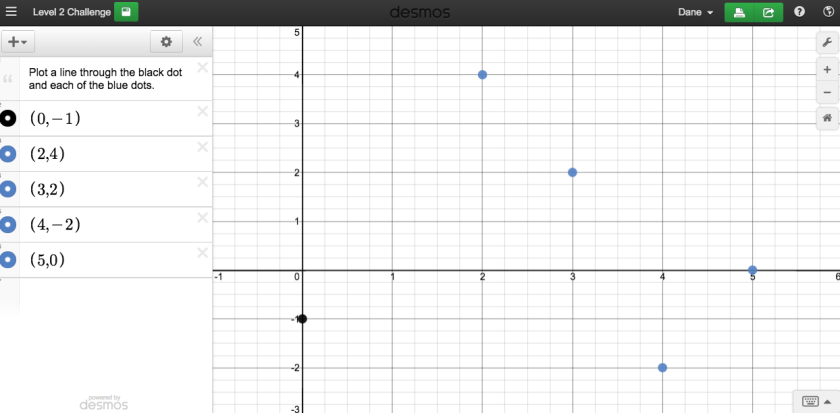I saw a student playing pool on his phone the other day, and it inspired me to create something in Desmos. That, along with Matt Vaudrey’s maze post and an old putt putt golf Desmos activity led to this.
The Links:
Breakdown:
My goal is for students to get more practice graphing lines with domain and range restrictions (always a challenge for my kids). In this game, the objective is to draw the path of the white ball hitting and sending another ball into a pocket. The 8 ball is not allowed to be touched.
I like this setup because there are many options for made shots. There is more than one “right” answer.
This also allows students to compare and present work because it isn’t the same presentation every time. Each student/group could have a different route to a solution. Speaking of sharing work, Cory Henwood provided a glimpse of an awesome strategy using Nearpod. Really great stuff.
Suggestion:
When using the putt putt version of this game, my students tend to struggle quite a bit. It’s been challenging trying to figure out a proper way to launch the task. However, I recently tried to ramp the lesson by starting the students with Michael Fenton-esque mini challenges (thanks to Matt’s maze post).
Begin with a level 1 challenge.
Most of the students are able to get through this and build some confidence. The strugglers are usually able to work with a group member to clear misconceptions. On to level 2…
Slightly more challenging, but again, most students will be able to get through it and build more confidence. Finally, it’s time to launch the putt putt/pool table challenge.
Using this strategy helped a lot and allowed more students to truly access the task. It was still a struggle in the end (more suggestions welcome), but I was much more pleased with the results.
How can the pool table challenges be improved? Thanks in advance for your feedback.
Update 1/23/17:
Patty Stephens made an awesome improvement to make this more realistic:
“If you want to model it in Desmos, an absolute value function would make the incoming/outgoing angles equal if reflecting off a horizontal or vertical line. I think you could use sliders to make the vertex a moveable point that would change the path of the ball depending on where it strikes the side of the pool table.
Here’s a little mockup I did for the cue ball shot, but I haven’t added an equation for the ball’s path.
https://www.desmos.com/calculator/uzfbuv0wjs“





Hey Dane, I really like this and the golf activity. I wonder if we could dig more deeply into the reflection aspect of a ball bouncing off a wall. That is, instead a right angle, it would bounce at an angle equal to the incoming angle. What might that look like in desmos?
Hey Geoff, thanks for the kind words! I’ve been thinking through your question for a while, and I’m struggling to find a good answer. I think it would be really cool to have something set up where the students can drag sliders to make a line for their first shot, and another equation is already set up to create a reflection line to preview the angle of the bounce.
The kids could drag sliders to determine their path and see the resulting bounce, adjust as necessary, and then write equations to recreate the shot that’s been modeled. What thoughts do you have in mind?
I think I actually need time to think about this. How does a slope of a line change generally when it bounces off an angle of incidence? I know the answer geometrically is that the outgoing angle is equal to the incoming angle. How does that translate to slopes of lines in a general sense?
I mean… the angle of reflection off a horizontal axis is just the negative of the incoming slope. What would it look like to reflect of a slanted obstacle?
Yeah that’s what I was struggling with. Geometrically it makes sense, but I’m not sure how to figure out angle measures algebraically based on this situation. Also, taking it to the next level by providing a slider-based equation for kids to explore with is what I would really like to figure out.
If you want to model it in Desmos, an absolute value function would make the incoming/outgoing angles equal if reflecting off a horizontal or vertical line. I think you could use sliders to make the vertex a moveable point that would change the path of the ball depending on where it strikes the side of the pool table.
This is a great idea! Thank you for the help! I’ve been wondering how to make it more realistic, and you found the answer. Thanks again!
Here’s a little mockup I did for the cue ball shot, but I haven’t added an equation for the ball’s path.
https://www.desmos.com/calculator/uzfbuv0wjs
This is awesome! I just updated the post to display your comments. Thanks again! Super pumped about this.